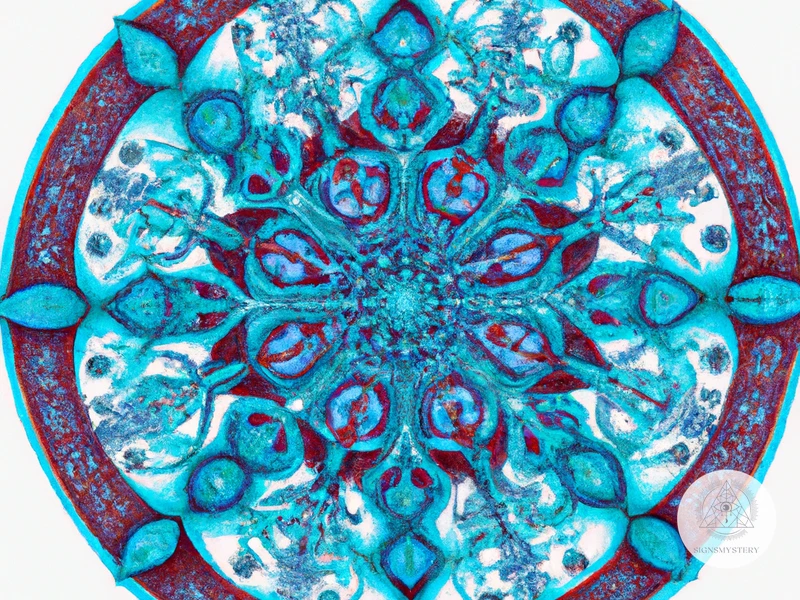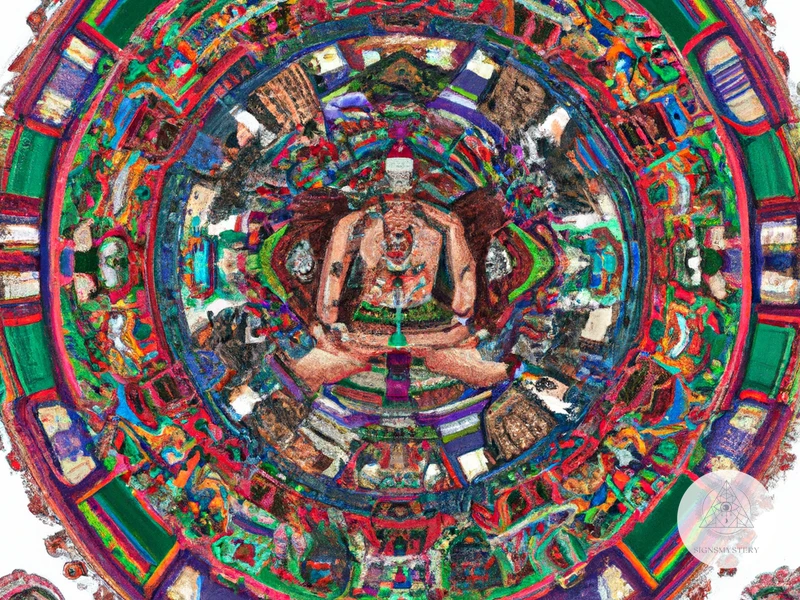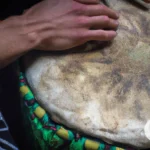The world of shamanism is full of intricate symbols and designs, and one of the most fascinating of these is the mandala. These circular designs have been used in spiritual practices for centuries, and they hold great significance for those who embrace shamanic principles. In this article, we’ll explore the different types of mandalas used in shamanism, as well as the history and meanings behind them. From healing and empowerment to contemplation and offerings, mandalas play a powerful role in shamanic rituals and practices. So, grab a cup of tea and settle in as we delve into the fascinating world of shamanic mandalas.
The History and Significance of Mandalas in Shamanism

Mandalas have a rich history in various cultures including Hinduism and Buddhism, but they are also significant in shamanism. In shamanic practices, mandalas are used as a tool for meditation, healing, and empowerment. They are often used in combination with shamanic altars, which serve as a sacred space for connecting with spirits and performing rituals.
In shamanism, mandalas represent the cosmos, and each symbol and color incorporated in the design has significant meaning. Creating a mandala is a transformative process, and the process of making it involves intention and focus. The use of mandalas in shamanism has become increasingly popular as more people seek spiritual guidance and connection. Mandalas and shamanic altars can be incorporated into daily spiritual routines or can be used for specific shamanic journeying or healing rituals.
What are Mandalas?
Mandalas are sacred symbols that have been used for centuries in various spiritual practices. The word “mandala” comes from the Sanskrit language and means “circle.” Mandalas are typically circular in shape, and they are often intricate designs made up of geometric patterns, shapes, and symbols. These symbols can vary widely depending on the culture or tradition that is using them, but they are always meaningful and significant.
In shamanism, Mandalas are used as a meditative tool to help practitioners connect with the spiritual realm. They are believed to represent the universe and are used to help focus the mind and create a sacred space. Mandalas are often created using natural materials such as sand, flowers, or leaves.
The use of Mandalas is commonly associated with Buddhist and Hindu traditions, but they are also significant in shamanic traditions. Shamans often use Mandalas in their healing practices, as they are believed to help restore balance to the individual’s mind, body, and spirit.
Mandalas have a rich history and are significant in many spiritual practices. They are often used as a symbol of the universe and as a tool for meditation and healing. Whether using Mandalas in a shamanic context or in another spiritual practice, they hold great importance and can be a powerful tool for inner transformation and spiritual growth.
The Use of Mandalas in Shamanism
Mandalas have been widely used in shamanism as a tool for spiritual practice and healing. They are used to aid in meditation, manifesting intentions, and accessing higher states of consciousness. Mandalas serve as a focal point for the mind, allowing the shaman to concentrate and enter a trance-like state. During shamanic rituals, mandalas can be placed on the shamanic altar as a sacred and powerful item.
One of the main uses of mandalas in shamanism is for healing. Mandalas can be used as a tool for healing routines or as part of shamanic journeying, which is a method for connecting to the spiritual realm. The shaman will create a healing mandala that resonates with the patient and place it on their body, allowing the patient to relax and enter a meditative state. The importance of mandalas on shamanic altars lies not only in their symbolism but also in their spiritual significance in shamanism.
Another use of mandalas in shamanism is for empowerment. Empowerment mandalas are designed to help the shaman connect with their inner power. These mandalas may include symbols or colors that represent personal empowerment to the individual shaman. The shaman may use an empowerment mandala as part of a ritual or meditation to help them feel a sense of strength and power.
Finally, mandalas are also used in shamanism to promote contemplation. The shaman may create a mandala that represents a particular question or intention, and then use it as a tool for contemplation and reflection. The contemplation mandala can be a helpful tool for gaining insights into personal issues, as well as for connecting to the spiritual realm.
The use of mandalas in shamanism is diverse and significant. They serve as a powerful tool for spiritual practice and healing, offering shamanic practitioners a way to connect with the spiritual realm and promote balance and harmony. Whether they are used for healing, contemplation, or empowerment, mandalas hold a special place in the hearts of shamanic practitioners as an essential component of their spiritual practice.
The Significance of Mandalas in Shamanism
The significance of mandalas in shamanism is deeply ingrained in the culture and practices of shamans. As a tool for spiritual development and connection, mandalas serve many purposes that are essential to the shamanic way of life. Mandalas are used as a form of meditation, protection, and healing. They also aid in the process of shamanic journeying, and serve as sacred altars for offerings and prayers.
In shamanic culture, mandalas are considered to be a form of sacred geometry, representing the organization and harmony of the universe. They are used to facilitate a connection with the divine and to create a ritual space that is protective and empowering. Mandalas can be seen as a physical manifestation of the spiritual realm, bridging the gap between the physical and non-physical worlds.
One of the most significant aspects of mandalas in shamanism is their ability to facilitate healing. Mandalas are often used as a focal point for meditation and prayer during healing rituals, helping individuals to connect with their own inner power and the energy of the universe. The act of creating a mandala can also be a healing experience, as it allows individuals to express their emotions and connect with their creativity.
Mandalas in shamanism also have a protective function, serving as a shield against negative energies and spirits. They can be used as a form of spiritual armor, helping individuals to maintain their connection to the divine while navigating the challenges of everyday life.
The significance of mandalas in shamanism cannot be overstated. They are a tool for spiritual development, healing, and protection that are deeply woven into the fabric of shamanic culture. Whether used as a form of meditation, altar, or protection, mandalas play an essential role in the shamanic way of life. For more information on the use of mandalas in shamanic altars and healing routines, check out the following resources: shamanic altar symbolism, mandalas in shamanic journeying, and mandalas in shamanic healing routines.
The Types of Mandalas in Shamanism
Shamanism utilizes various types of mandalas, each with their own unique purpose. The healing mandala is used for physical, emotional, and spiritual healing. The contemplative mandala is used for meditation, reflection, and self-awareness. The offering mandala is used to express gratitude and make offerings to the spirits. And the empowerment mandala is used to strengthen and empower the practitioner. Understanding these different types of mandalas and their significance can enhance one’s practice and deepen their connection with the spirits.
The Healing Mandala
The Healing Mandala is a powerful tool used in shamanic healing practices. This type of mandala is designed to promote physical, emotional, and spiritual healing. It is believed that the symmetry and patterns within the mandala can help to restore balance and harmony within the body and mind.
Healing Mandalas can be created using a variety of designs and symbols, such as circles, leaves, flowers, and other natural elements. Each element within the mandala is chosen for its specific healing properties and is arranged in a way that promotes healing energy flow throughout the body.
Here are some common elements that are often used in Healing Mandalas and their healing properties:
| Element | Healing Properties |
|---|---|
| Circles | Represents wholeness and unity |
| Leaves | Symbolizes growth, change, and renewal |
| Flowers | Represents beauty and interconnectedness |
| Crystals | Believed to have healing properties and promote balance and harmony |
| Colors | Each color has its own healing properties, such as blue for calming and red for energizing |
The process of creating a Healing Mandala can be a meditative practice in itself. It involves focusing on the intention of promoting healing and arranging the elements in a way that supports that intention. Once the mandala is complete, it can be used in healing practices such as meditation or placed on the body during energy healing sessions.
The Healing Mandala is a powerful and versatile tool in shamanic healing practices. Its use of natural elements and intentional arrangement make it a unique and effective way to promote physical, emotional, and spiritual healing.
The Contemplative Mandala
The Contemplative Mandala is a type of mandala that is known for its emphasis on contemplation and introspection. It is typically created using intricate patterns and designs that are meant to capture the attention of the viewer and draw them into a state of deep reflection.
One of the key characteristics of the Contemplative Mandala is its use of symmetry and balance. The design is often centered around a single point, with repeating patterns radiating outwards in perfect harmony. This creates a sense of order and stability that is visually appealing and calming to the mind.
Examples of Contemplative Mandalas
Here are some examples of Contemplative Mandalas that you may come across:
| Name of Mandala | Description |
| The Flower Mandala | This mandala features a central flower surrounded by geometric shapes and patterns. The flower is often depicted with great detail, and its petals are used to create the repeating patterns. |
| The Yantra Mandala | This mandala is often used in Hindu and Buddhist traditions. It features a central deity or symbol surrounded by repeating geometric patterns and shapes. |
| The Lotus Mandala | This mandala features a lotus flower as its central design element. The lotus is often associated with spiritual enlightenment and purity, making it a popular choice for this type of mandala. |
The Significance of the Contemplative Mandala
The Contemplative Mandala is often used as a tool for meditation and self-reflection. It is believed that by focusing on the intricate patterns and designs, the mind is able to enter into a state of deep contemplation and introspection. This can be a powerful tool for personal growth and spiritual development.
The Contemplative Mandala is also thought to have a balancing effect on the mind and body. Its use of symmetry and order is believed to bring a sense of harmony and balance to one’s inner world, helping to promote a sense of peace and wellbeing.
Conclusion
The Contemplative Mandala is a powerful tool for meditation and introspection. Its intricate patterns and designs are specifically created to draw the viewer into a deep state of contemplation and self-reflection. Whether used for personal growth or spiritual development, the Contemplative Mandala is a beautiful and meaningful addition to any shamanic practice.
The Offering Mandala
The Offering Mandala is a type of mandala used in shamanism for offerings and prayers. It is a sacred and symbolic representation of an offering to the divine, and it is used to create a connection between the practitioner and the spiritual realm. In shamanic traditions, offerings are seen as a way of giving back to the spirits and seeking their blessings, guidance, and protection.
The Structure of Offering Mandalas
Offering mandalas are typically circular and feature a central deity or spiritual figure surrounded by smaller deities or auspicious symbols. The center of the mandala is often adorned with offerings such as flowers, grains, fruits, and water. The outer circles of the mandala may contain depictions of the five elements – earth, water, fire, air, and space – and other offerings such as jewels, incense, and sacred texts.
The Significance of Offerings
In shamanism, offerings are seen as a way of honoring the spirits and building a connection with them. The act of giving creates a relationship between the practitioner and the spirits, and it is believed that the spirits will reciprocate by providing blessings and guidance. Offerings are also seen as a way of purifying negative karma and accumulating positive karma.
The Practice of Making Offerings
To create an offering mandala, the practitioner first prepares the offerings with care and intention. Each offering is selected for its symbolic meaning and purity, and it is arranged in a specific pattern around the central deity or spiritual figure. The practitioner then recites prayers or mantras to invoke the spirits, and the mandala is offered to them.
The Benefits of Using Offering Mandalas in Shamanism
Offering mandalas are used in shamanism for a variety of purposes, including seeking blessings, protection, and guidance, purifying negative karma, and accumulating positive karma. They are also used for specific purposes such as healing, empowerment, and prosperity. By offering pure and beautiful objects to the spirits, the practitioner creates a positive connection and gains their support.
The Offering Mandala is a powerful tool in shamanic practice for creating a connection with the spirits and seeking their blessings. By making offerings with intention and devotion, the practitioner can purify negative karma and accumulate positive karma, and gain the support and guidance of the spiritual realm.
The Empowerment Mandala
The Empowerment Mandala is a powerful tool used in Shamanism to enhance personal power and inner strength. This type of mandala is characterized by geometric patterns that represent the different aspects of personal empowerment. The Empowerment Mandala is designed to help the individual tap into their innermost resources and connect with the energies of the universe.
The Empowerment Mandala is typically created using vibrant colors that represent the different aspects of personal power. Each color is associated with a specific energy and has its own unique meaning. For example, red symbolizes passion and vitality, while yellow represents clarity and wisdom. The use of color in the Empowerment Mandala is intended to help the individual connect with their innermost resources and tap into their personal power.
The Empowerment Mandala is also characterized by specific symbols that represent the different aspects of personal power. The use of symbols is intended to help the individual focus their energy and attention, allowing them to connect more deeply with the universe. Typical symbols used in the Empowerment Mandala include the sun, moon, stars, and various animals.
To use the Empowerment Mandala in your own practice, it is important to first understand the specific meanings behind the colors and symbols used. This can be accomplished through research or guidance from a Shamanic practitioner. Once you have a basic understanding of the different aspects of personal power, you can begin using the Empowerment Mandala in your own meditation and contemplation practices.
One common technique for using the Empowerment Mandala is to simply sit quietly and focus on the mandala. As you do so, visualize the different colors and symbols and allow yourself to feel their energy. You may also choose to incorporate specific affirmations or intentions into your practice, such as “I am strong and capable,” or “I embrace my inner power.” As you continue to work with the Empowerment Mandala, you may find that you are able to tap into your innermost resources more easily, allowing you to feel more empowered and connected with the universe.
The Meanings Behind Shamanic Mandalas

Shamanic mandalas are not just beautiful pieces of art; they are rich in symbolism that can provide insight into the deeper meanings of life. Colors, shapes, and symbols all play important roles in the interpretation of mandalas in shamanism. Colors, for example, each have their own meaning. Red represents passion and vitality, yellow symbolizes wisdom and strength, and blue represents calmness and intuition, among others. On the other hand, shapes like circles represent unity and wholeness, while triangles stand for balance and harmony. Symbols like animals and plants, on the other hand, represent different qualities like strength, protection, and healing. By understanding the meanings behind the colors, shapes, and symbols in shamanic mandalas, you can gain new insights and perspectives on your own life.
The Interpretation of Colors
The Interpretation of Colors in Shamanic Mandalas holds great significance in understanding the meaning and symbolism of the mandalas. Each color represents a different aspect of life and the universe. Here are some of the primary colors used in mandalas and their interpretations:
| Color | Interpretation |
|---|---|
| Red | Represents strength, power, and energy. It also symbolizes the life force and the physical body. |
| Orange | Represents creativity, transformation, and self-awareness. It is also associated with the emotions and the reproductive system. |
| Yellow | Represents wisdom, knowledge, and enlightenment. It is also associated with the digestive system and the energy of the sun. |
| Green | Represents balance, growth, and healing. It is also associated with the heart chakra and the energy of nature. |
| Blue | Represents communication, expression, and spiritual awareness. It is also associated with the throat chakra and the energy of the sky and water. |
| Purple | Represents intuition, mysticism, and spiritual enlightenment. It is also associated with the crown chakra and the energy of the universe. |
| White | Represents purity, clarity, and spiritual awakening. It is also associated with the energy of the moon and higher consciousness. |
| Black | Represents mystery, transformation, and the unknown. It is also associated with the subconscious mind and the energy of the void. |
Understanding the interpretation of colors in shamanic mandalas can help us to better understand our own emotions, thoughts, and experiences. Additionally, it can help us to connect with the energy of the universe and access our own spiritual and creative potential.
The Significance of Shapes and Symbols
In shamanic mandalas, shapes and symbols hold a significant role in their interpretation and meaning. Each shape represents a specific aspect of spiritual and physical existences and can offer insight into the purpose of a particular mandala.
Circle: A circle is a universal symbol found in cultures worldwide. It represents the cycle of life, creation, and eternity. In Shamanism, the circle represents wholeness and completeness.
Square: The square represents the wholeness of the Earth, stability, and foundation. It symbolizes the four cardinal directions, which are crucial in Shamanic practice.
Triangle: The triangle symbolizes the spiritual and physical realms combined. It can also represent the three worlds of Shamanism – the underworld, Earth, and heaven.
Spiral: The spiral represents growth, development, evolution, and change. It is a symbol of change and transformation in Shamanic practice.
Flowers: Flowers hold symbolic meaning in Shamanism. They can indicate the representation of various spirits or beings, depending on the type of flower used.
Animals:
Subscribe to Our Newsletter
Sign up to receive the latest news and updates.
Colors: Colors in mandalas also hold significant symbolic meaning. Each color represents a particular energy or emotion. For example, red is associated with passion, vitality, and strength, while blue represents calmness and relaxation.
Understanding the significance of shapes and symbols in Shamanic mandalas can provide a deeper understanding of their intended purpose and benefit the individual who uses them. By interpreting the meaning behind each symbol, a person can use the mandala to work through personal challenges, gain insight into spiritual practices, and aid in personal growth and transformation.
How Shamanic Mandalas are Created
Shamanic mandalas are created through a deliberate and intentional process that involves both inner and outer planning. The creation process is a meditative and contemplative practice, often guided by the shaman’s intention for the mandala’s purpose. Typically, mandalas are created on a flat surface, such as a piece of paper, cloth, or sand. The materials used to create the mandala also hold significance, with many shamans choosing natural elements such as stones, crystals, flowers, and herbs to represent different symbols and meanings. The process of creating a mandala can take hours or even days, as each element is carefully placed with the intention of creating a sacred and harmonious design. Once complete, the mandala is often used in shamanic practices such as meditation, healing, and empowerment.
The Creation Process
Shamanic mandalas can be created using a variety of materials, from sand and stones to paint and paper. The materials used can vary depending on the intended purpose and personal preference of the shaman or individual creating the mandala.
Here are the steps involved in the creation process of a shamanic mandala:
| Step 1: | Gather your materials. Consider what materials you would like to use for your mandala. This can include natural elements such as leaves, flowers, stones, and feathers or man-made materials such as paint, paper, and glue. |
| Step 2: | Set your intention. Before beginning the mandala, take a moment to set an intention for its purpose. This can be for healing, contemplation, or empowerment, among other things. |
| Step 3: | Create your base. Select a surface for your mandala, such as a piece of paper or a patch of sand. This will serve as a base for your design. |
| Step 4: | Start building your mandala. Start arranging your materials on the surface, beginning from the center and working outward. Consider the shapes, colors, and symbols you are using and how they relate to your intention. |
| Step 5: | Allow your intuition to guide you. As you create your mandala, allow your intuition to guide you and trust the process. There are no wrong choices when creating a shamanic mandala. |
| Step 6: | Complete your mandala. Once you feel finished with your mandala, take a moment to admire it and connect with its energy. You can then use it for whatever purpose you set your intention for, such as meditation or healing. |
Remember, creating a shamanic mandala is a personal and intuitive process. There is no right or wrong way to do it, and each mandala will be unique. Allow yourself to be creative and follow your intuition as you create your own shamanic mandalas.
The Use of Natural Materials in Mandala Making
The use of natural materials in mandala making has a long tradition in shamanism. In fact, shamanic mandalas are usually made with natural materials found in the environment. These materials may include leaves, stones, flowers, shells and sand. The use of natural materials is considered important because they are believed to have specific energy frequencies that enhance the healing and spiritual power of the mandala.
Natural materials that are used in mandala making are usually chosen for their color, texture, and shape. Each natural material is believed to have a unique symbolic meaning and is carefully chosen to create a specific intention in the mandala.
Here is an example of some natural materials commonly used in shamanic mandala making:
| Natural Material | Symbolic Meaning |
|---|---|
| Feathers | Represents air, freedom, transcendence, and the power of flight. |
| Stones | Symbolizes strength, grounding, stability, and the power of the earth. |
| Flowers | Represents beauty, growth, change, and the power of rebirth. |
| Leaves | Symbolizes growth, renewal, vitality, and the power of the plant kingdom. |
| Shells | Represents the ocean, the moon, intuition, and the power of the feminine. |
The natural materials are often arranged in a circular pattern, representing the wholeness and interconnectedness of all things. As the mandala is created, the shaman may use a specific intention or prayer to imbue the mandala with specific energies or qualities, such as healing, balance, or spiritual guidance. The finished mandala is then used as a focus for meditation or ritual practice.
The use of natural materials in mandala making is a powerful technique for connecting with the natural world and tapping into the spiritual energies that surround us. Whether used for healing, meditation or spiritual exploration, shamanic mandalas are a beautiful and meaningful way to deepen your connection to yourself and the world around you.
How to Use Shamanic Mandalas in Your Own Practice
Using shamanic mandalas in your own practice can be a transformative experience. A great way to incorporate mandalas into your daily spiritual routine is by using them for meditation and contemplation. Begin by setting an intention for your meditation practice while focusing on the center of the mandala. Allow your mind to wander freely and explore the different symbols, shapes, and colors within the mandala. Another way to use mandalas is for healing and empowerment practices. You can use mandalas as a focal point during a healing session and visualize the energy flowing through the mandala into your body. By practicing with mandalas regularly, you can enhance your spiritual practice and connect with the profound wisdom of shamanic traditions.
Using Mandalas for Meditation and Contemplation
Using Mandalas for Meditation and Contemplation is one of the most popular ways in which the mandalas are used in Shamanism. With their intricate designs and patterns, mandalas help the viewers to calm their minds and enter into deep meditative states.
Mandalas can be used in a variety of ways for meditation and contemplation. Some people prefer to simply view the mandalas while others may prefer to color them in or even create their own.
Here are some ways to use mandalas for meditation and contemplation:
| Technique | Description |
| Mandala Gazing | Choose a mandala that resonates with you and place it in front of you. Sit comfortably and gaze at the mandala. Allow your mind to become still and calm, allowing the mandala to draw you in. Try to keep your gaze soft and relaxed. |
| Mandala Coloring | Choose a mandala and color it in using colors that you are drawn to. Focus on the act of coloring and allow your mind to become still and focused on the present moment. |
| Mandala Creation | Create your own mandala using paper and any other materials that resonate with you. As you work on your mandala, allow your mind to become focused on the present moment and let go of any distracting thoughts. |
Using mandalas for meditation and contemplation is a powerful way to connect with the self and the universe. By focusing on the intricate patterns and designs of the mandalas, one can enter into a deep meditative state and gain access to inner wisdom and spiritual insights. So why not try using mandalas in your own practice and experience the profound benefits for yourself?
Using Mandalas for Healing and Empowerment Practices
Mandalas have been used for centuries as a tool for healing and empowerment practices. When using a mandala for these purposes, it is important to have a clear intention in mind. The intention can range from physical healing, mental clarity, spiritual awakening, or any other desired healing or empowerment outcome.
To use a mandala for healing, start by choosing a mandala that resonates with your intention. This could be a mandala with specific colors or symbols that relate to your desired outcome. Sit in a quiet space and focus your attention on the mandala. Allow yourself to get lost in the patterns and colors, breathing deeply and slowly.
As you focus on the mandala, allow any emotions or sensations to arise and acknowledge them without judgment. Continue to breathe and focus on the mandala, allowing it to guide your thoughts and intentions towards healing and empowerment.
Some people find it helpful to incorporate affirmations or mantras into their mandala practice. For example, you could repeat to yourself phrases such as “I am healed”, “I am empowered”, or “I am worthy”. This can help to reinforce your intention and bring a deeper level of healing and empowerment to your practice.
When using a mandala for empowerment, it is important to focus on the qualities that you wish to cultivate within yourself. This could be confidence, strength, courage, or any other desired quality. Choose a mandala that resonates with these qualities and again, sit in a quiet space and focus your attention on the mandala.
As you focus on the mandala, allow the qualities you wish to cultivate to come to the forefront of your mind. Visualize yourself embodying these qualities and allow the mandala to serve as a guide towards cultivating them within yourself.
Remember that using mandalas for healing and empowerment practices is a deeply personal process. It is important to trust your intuition and allow the mandala to guide you towards your desired outcome. With time and practice, you may find that your mandala practice brings a deeper level of healing and empowerment to your life.
Conclusion
In conclusion, it is clear that mandalas hold a significant place in the practice of shamanism. As we explored, there are several types of mandalas, each with its unique purpose and meaning. The healing mandala is used to promote physical and emotional healing, while the contemplative mandala is used for meditation and reflection. The offering mandala is used in ritual ceremonies to offer gratitude and respect to higher powers, while the empowerment mandala is used to improve inner strength and personal power.
It is also evident that the colors, shapes, and symbols used in shamanic mandalas hold great significance, and their interpretation can provide insight into one’s spiritual journey. Creating a mandala can be a therapeutic and meditative process, made even more meaningful by using natural materials like stones or sand.
Overall, incorporating shamanic mandalas into one’s practice can provide a powerful tool for healing, self-discovery, and spiritual growth. Whether using mandalas for meditation or as part of a healing or empowerment practice, they offer a unique and profound experience to those who work with them.
As with any spiritual practice, it is essential to approach the use of mandalas with respect and intention. For those interested in incorporating mandalas into their practice, perhaps start by exploring the different types and their meanings, experimenting with creating your own mandalas, or seeking the guidance of a practiced shaman. With an open mind and a respectful approach, shamanic mandalas can offer a powerful tool for personal and spiritual growth.
Frequently Asked Questions
1. What is the significance of Mandalas in Shamanism?
Mandalas are significant in Shamanism as they are believed to have the power to connect the individual to the spiritual world and facilitate healing and self-discovery.
2. What are the different types of Mandalas in Shamanism?
The different types of Mandalas in Shamanism are the Healing Mandala, the Contemplative Mandala, the Offering Mandala, and the Empowerment Mandala. Each type has its own specific purpose and symbolism.
3. What is the purpose of the Healing Mandala?
The purpose of the Healing Mandala is to aid in physical, emotional, and spiritual healing. Its design is meant to promote a sense of peace and harmony within the individual.
4. What is the Contemplative Mandala used for?
The Contemplative Mandala is used for meditation and self-reflection. Its design is meant to focus the mind and center the individual.
5. What is the Offering Mandala?
The Offering Mandala is used as a way to express gratitude and make offerings to ancestors, spirits, or deities. Its design often incorporates offerings such as flowers, grains, or other meaningful objects.
6. What is the Empowerment Mandala?
The Empowerment Mandala is used to facilitate personal growth and empowerment. Its design often includes symbols of strength and transformation.
7. What do the colors of a Shamanic Mandala represent?
The colors of a Shamanic Mandala are believed to have specific meanings and symbolism. For example, red can represent strength and passion, while blue can represent peace and tranquility.
8. What do the symbols and shapes in Shamanic Mandalas represent?
The symbols and shapes in Shamanic Mandalas represent various aspects of the spiritual world and the individual’s inner psyche. For example, a circle can represent unity and wholeness, while a triangle can represent balance and stability.
9. Can anyone create a Shamanic Mandala?
Yes, anyone can create a Shamanic Mandala. It is a personal practice that can be adapted and modified based on individual beliefs and values.
10. How can I use a Shamanic Mandala in my own practice?
You can use a Shamanic Mandala in your own practice by incorporating it into your meditation or self-reflection routine. You can also use it as a focal point for healing practices or to express gratitude and make offerings.










